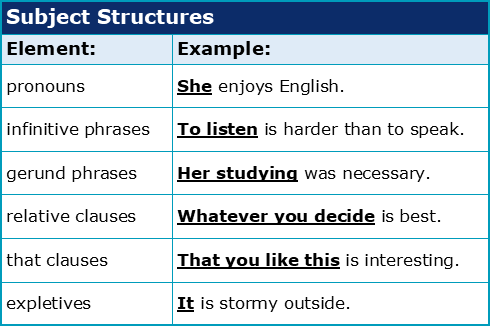How are subject NPs useful for academic English?

This is the second of three chapters about Subjects and Objects. To complete this reader, read each chapter carefully and then unlock and complete our materials to check your understanding.
– Explore subject phrase functions in significant detail
– Provide examples of the various structures of subjects
– Discuss how helpful subjects are in academic assignments
Before you begin reading...
-
video and audio texts
-
knowledge checks and quizzes
-
skills practices, tasks and assignments
Chapter 2
In our first chapter of this reader, we introduced the basic concepts of subjects and objects and compared these two phrase functions. We learned that subjects are usually written before the verb in a sentence and are the doer of the action of a verb, while objects are found after verbs and are the receiver of those actions. We also learned that subjects are most commonly made up of noun phrases (NPs). In this second chapter, we next focus on the grammar of subjects and explore their rules and uses in academic contexts such as essays.

What is a subject noun phrase?
A noun phrase is a collection of words that has a noun as its key part and which functions like a singular noun when combined. Look at the subjects in the two expressions below for example in which the key noun of each [noun phrase] is bold:

Clearly noun phrases such as these can be composed of many word types that are not nouns. When we break these two examples into pieces for instance, we can see a multitude of types (adjectives, conjunctions, determiners etc.) in each expression:
- the [determiner] tired [adjective] and [conjunction] weary [adjective] scientist [key noun]
- some [quantifier] types [noun] of [preposition] British [adjective] people [key noun]
- Are subjects only made of noun phrases?
While subjects are most commonly composed of noun phrases as previously explored, this is not always the case. There is in fact a lot of variation in how subjects might be formed, from singular pronouns to whole phrases and clauses:

Relying on the noun-phrase form of a subject is clearly not a consistent method of identification. Instead, students should remember the function of subjects within a sentence and their common placement before the predicate verb phrase.
How long can a subject be?
What many students may also find challenging (or interesting) is that subjects can also be of almost any length. Subjects can be one word long, or they can be one hundred words long – or more! Take a look at the following example in which the subject of the sentence is written within the [square brackets]:
[The scientist sitting over there with the hat on and dark blue jeans who discovered dark matter and who lived next door to me for that brief period between 1999 and 2001 when I was a university freshman at Harvard] is called Dr Samwise Smith.

While such long subjects may be difficult to understand, recall or repeat, they are in fact quite grammatical. Knowing that long subjects such as these are usually formed by combining prepositional phrases (‘with the hat on’) and relative clauses (‘who discovered dark matter’) may help students to identify them.
Are subjects useful in EAP?
Seeing as almost all clauses and sentences require subjects to be grammatical, it would not be possible to form almost any academic English (EAP) expression without using them. Subjects can therefore be useful when…
…forming thesis statements
“This paper evaluates the impacts of second-hand smoking on the vulnerable population.”
…referring to tables or figures
“The graph in figure four clearly demonstrates this increase.”
…explaining the results of an experiment
“What these results tell us is that smoking is clearly having a damaging effect.”
…introducing source-based opinions
“Jones (2012) claims that this decrease is likely due to government campaigns.”
…writing definitions, explanations and implications
“Tobacco smoke is a complex mixture of carcinogens and impurities.”
…introducing historical events
“In 1945, the second world war finally came to an end and the fighting stopped.”
…providing topical background information
“The concept was coined in 1997 when Johnson published his first paper.”
…summarising published research
“Many studies have reported an increase in pollution over the years.”
Why is subject-verb agreement important?
Finally, when forming subjects correctly, it’s important that university students avoid making errors. This means correctly identifying the necessary subject-verb agreement of a sentence, making sure that a subject and its associated verb agree in both person and number. Native speakers would say, for example, “the teacher speaks four languages” NOT “the teacher speak four languages”.
For more information about subject-verb agreement, visit our short reader on that topic. Otherwise, unlock, download and complete our Chapter 2 Worksheet and continue studying with Chapter 3 about direct, indirect and oblique objects.
Downloadables
Once you’ve completed all three chapters in this short reader about Subjects and Objects, you might then wish to download our Chapter Worksheets to check your progress or print for your students. These professional PDF worksheets can be easily accessed for only a few Academic Marks.
Chapter 1 explores the topic: What are subject and object phrase functions? Our Chapter 1 Worksheet (containing guidance, activities and answer keys) can be accessed here at the click of a button.
Chapter 2 explores the topic: How are subject NPs useful for academic English? Our Chapter 2 Worksheet (containing guidance, activities and answer keys) can be accessed here at the click of a button.
Chapter 3 explores the topic: Do essays use direct, indirect and oblique objects? Our Chapter 3 Worksheet (containing guidance, activities and answer keys) can be accessed here at the click of a button.
To save yourself 2 Marks, click on the button below to gain unlimited access to all of our Subjects and Objects Chapter Worksheets. This All-in-1 Pack includes every chapter, activity and answer key related to this topic in one handy and professional PDF.
Collect Academic Marks
-
100 Marks for joining
-
25 Marks for daily e-learning
-
100-200 for feedback/testimonials
-
100-500 for referring your colleages/friends